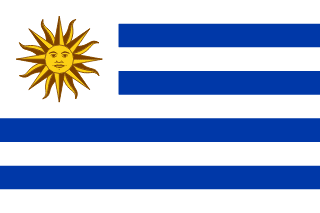Uruguay - Geography

Here, let us take a look at the Geography of Uruguay. Second-smallest South American country (after Suriname); most of the low-lying landscape (three-quarters of the country) is grassland, ideal for cattle and sheep. Mother's mean age at first birth is (), whereas, the Maternal mortality ratio is 15 deaths/100,000 live births (2023 est.)
Geographical data of Uruguay
| Location | Southern South America, bordering the South Atlantic Ocean, between Argentina and Brazil |
|---|---|
| Geographic coordinates | 33 00 S, 56 00 W |
| Map references | South America |
| Tarrain | mostly rolling plains and low hills; fertile coastal lowland |
| Natural Resources | arable land, hydropower, minor minerals, fish |
| Natural Hazards | seasonally high winds (the pampero is a chilly and occasional violent wind that blows north from the Argentine pampas), droughts, floods; because of the absence of mountains, which act as weather barriers, all locations are particularly vulnerable to rapid changes from weather fronts |
| Irrigated Land | 2,230 sq km (2018) |
| Major rivers (by length in km) | Rio de la Plata/Parana river mouth (shared with Brazil [s], Argentina, Paraguay) - 4,880 km; Uruguay river mouth (shared with Brazil [s] and Argentina) - 1,610 km note: [s] after country name indicates river source; [m] after country name indicates river mouth |
| Major aquifers | Guarani Aquifer System |
| Land Boundaries | 1,591 km |
| Border Countries | Argentina 541 km; Brazil 1,050 km |
| Coastline | 660 km |
| Climate | warm temperate; freezing temperatures almost unknown |
| Area | |
| Total Area | |
| Land Area | 175,015 sq km |
| Water Area | 1,200 sq km |
| comparative Area | about the size of Virginia and West Virginia combined; slightly smaller than the state of Washington |
| Maritime Claims | |
| Territorial sea | 12 nm |
| Contiguous zone | 24 nm |
| Exclusive economic zone | 200 nm |
| Continental shelf | 200 nm or the edge of continental margin |
| Elevations | |
| Highest point | Cerro Catedral 514 m |
| Lowest point | Atlantic Ocean 0 m |
| Mean elevation | 109 m |
| Land Use | |
| Agricultural land | 81.4% (2023 est.) |
| Agricultural land: arable land | arable land: 12.6% (2023 est.) |
| Agricultural land: permanent crops | permanent crops: 0.2% (2023 est.) |
| Agricultural land: permanent pasture | permanent pasture: 68.6% (2023 est.) |
| Forest | 11.4% (2023 est.) |
| Other | 7.3% (2023 est.) |
Population Distribution
Most of the country's population resides in the southern half of the country; approximately 80% of the populace is urban; nearly half of the population lives in and around the capital of Montevideo
People and Society
In Uruguay, the different Ethnic groups are such that we have: White 87.7%, Black 4.6%, Indigenous 2.4%, other 0.3%, none or unspecified 5% (2011 est.)
| Population | |
|---|---|
| Pop growth rate | 0.26% (2024 est.) |
| Birth rate | 12.6 births/1,000 population (2024 est.) |
| Death rate | 9.1 deaths/1,000 population (2024 est.) |
| Health expenditure | |
| Physicians Density | |
| Hospital bed Density | 2.5 beds/1,000 population (2021 est.) |
| Total fertility rate | 1.75 children born/woman (2024 est.) |
| Gross reproduction rate | 0.86 (2024 est.) |
| Contraceptive prevalence rate | |
| Est married women (ages 15-49) | 55.4% (2023 est.) |
| Literacy | |
| Education expenditures | |
| Net Migration rate | -0.9 migrant(s)/1,000 population (2024 est.) |
| Nationality | Uruguayan | Uruguayan(s) |
| Languages | |
| Religions | Roman Catholic 36.5%, Protestant 5% (Evangelical (non-specific) 4.6%, Adventist 0.2%, Protestant (non-specific) 0.3%), African American Cults/Umbanda 2.8%, Jehovah's Witness 0.6%, Church of Jesus Christ 0.2%, other 1%, Believer (not belonging to the church) 1.8%, agnostic 0.3%, atheist 1.3%, none 47.3%, unspecified 3.4% Roman Catholic 42%, Protestant 15%, other 6%, agnostic 3%, atheist 10%, unspecified 24% (2023 est.) |
| Age Structure | |
| 0-14 years | 18.9% (male 329,268/female 317,925) |
| 15-64 years | 65.4% (male 1,112,622/female 1,128,418) |
| 65 years and over | 15.7% (2024 est.) (male 218,242/female 318,855) |
| Dependency Ratios | |
| Total dependency ratio | 49.1 (2024 est.) |
| Youth dependency ratio | 26.9 (2024 est.) |
| Elderly dependency ratio | 22.2 (2024 est.) |
| Potential support ratio | 4.5 (2024 est.) |
| Median Age | |
| Total | 36.5 years (2024 est.) |
| Male | 34.9 years |
| Female | 38.2 years |
| Urbanization | |
| Urban population | 95.8% of total population (2023) |
| Rate of urbanization | 0.4% annual rate of change (2020-25 est.) |
| Major urban areas (Pop) | 1.774 million MONTEVIDEO (capital) (2023). |
| Sex Ratio | |
| At birth | 1.04 male(s)/female |
| 0-14 years | 1.04 male(s)/female |
| 15-64 years | 0.99 male(s)/female |
| 65 years and over | 0.68 male(s)/female |
| Total population | 0.94 male(s)/female (2024 est.) |
| Infant Motality | |
| Total | 8 deaths/1,000 live births (2024 est.) |
| Male | 9.1 deaths/1,000 live births |
| Female | 6.8 deaths/1,000 live births |
| Life Expectancy at birth | |
| Total population | 78.9 years (2024 est.) |
| Male | 75.8 years |
| Female | 82.1 years |
| Drinking Water Sources | |
| Improved: urban | urban: 99.7% of population (2022 est.) |
| Improved: rural | rural: 95.3% of population (2022 est.) |
| Improved: total | total: 99.5% of population (2022 est.) |
| Unimproved: urban | urban: 0.3% of population (2022 est.) |
| Unimproved: rural | rural: 4.7% of population (2022 est.) |
| Unimproved: total | total: 0.5% of population (2022 est.) |
| Sanitation facility acess | |
| Improved: urban | urban: 99.3% of population (2022 est.) |
| Improved: rural | rural: 100% of population (2022 est.) |
| Improved: total | total: 99.3% of population (2022 est.) |
| Unimproved: urban | urban: 0.7% of population (2022 est.) |
| Unimproved: rural | rural: 0% of population (2022 est.) |
| Unimproved: total | total: 0.7% of population (2022 est.) |
| Alcohol consumption per capita | |
| Total | 5.42 liters of pure alcohol (2019 est.) |
| Beer | 1.86 liters of pure alcohol (2019 est.) |
| Wine | 2.86 liters of pure alcohol (2019 est.) |
| Spirits | 0.71 liters of pure alcohol (2019 est.) |
| Other alcohols | 0 liters of pure alcohol (2019 est.) |
| Tobacco use | |
| Total | 18% (2025 est.) |
| Male | 21.3% (2025 est.) |
| Female | 14.9% (2025 est.) |
Demographic profile
All Important Facts about Uruguay
Want to know more about Uruguay? Check all different factbooks for Uruguay below.









